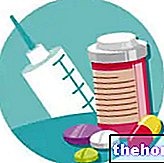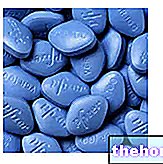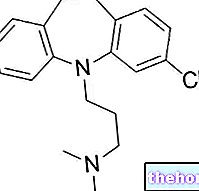
Within this group there are various active ingredients which - through different mechanisms of action - are able to favor the resolution of the problem.
Before going into the more detailed description of anti-ulcer drugs, however, it is useful to remember what the ulcer is, how gastric acid is produced and what are the defense systems that our body uses to preserve the gastric mucosa from aggression from the acidic environment of the stomach itself.
stomach and / or duodenum. If this erosion also affects the submucosa, it is called a hemorrhagic ulcer (since the submucosa is richly vascularized).The ulcer is formed when the balance between the protective and aggressive factors to which the stomach and duodenum are exposed is lacking. The cytoprotective elements consist of mucoproteins and bicarbonate ions; aggressive ones from hydrochloric acid and pepsin.
Aggressive Factors
Responsible for the strong acidity of the gastric contents is hydrochloric acid (HCl), which is continuously produced and poured into the stomach, even if in different quantities at various times of the day. Hydrochloric acid is essential to guarantee the optimal functionality of a enzyme, called pepsin, responsible for the digestion of proteins. The combination of hydrochloric acid, pepsin and other enzymes produced by the stomach make up the gastric juice.
Proton Pump: What Is It And What Is It For?
The parietal cells have the task of secreting HCl in the lumen of the stomach; inside them, the functional unit is constituted by the so-called proton pump, also known as H⁺ / K⁺ ATPase. Despite the complicated name, it is actually a "simple" enzyme - therefore a protein - responsible for the exchange of protons H⁺ with potassium ions K⁺. Combining with chlorine ions (Cl⁻), the H⁺ thus give rise to hydrochloric acid (HCl).
As mentioned, this proton pump works continuously, even on an empty stomach (albeit more slowly).
The substances capable of stimulating the activity of the proton pump are essentially three:
- Gastrin (a peptide hormone of 17 amino acids, many of which are acids);
- L "acetylcholine;
- The histamine.
All these substances interact on their receptors located at the level of the parietal cell membrane:
- CCK2 for gastrin;
- M3 muscarinic receptors for acetylcholine;
- H2 receptors for histamine.
The stimulation of these receptors, through a series of intracellular mechanisms, therefore stimulates the activity of the proton pump. Acetylcholine and gastrin increase the entry of calcium ions, histamine activates the enzyme adenylate cyclase and increases the cyclic AMP concentration This action is called direct stimulation.
Gastrin and acetylcholine can also interact, always with their own receptors, with cells (called similar enterochromaffins) that contain histamine (thus indirectly stimulating the parietal cell to produce HCl). This action is called indirect stimulation.
Mucosa protective factors
Each epithelial cell present in the gastric mucosa continuously secretes proteins - mucoproteins - which participate in the constitution of a viscous liquid called mucus. The latter, by stratifying on the mucous membranes of the stomach, forms a fairly thick layer that performs an important protective function, in turn enhanced by the bicarbonate anions (HCO3-) which are secreted by the epithelial cells themselves. The efficacy of these protective systems is such as to maintain, near the gastric mucosa, a pH close to neutral, despite the fact that very high levels of acidity are reached in the internal lumen (pH values between 1 and 3).
Among the protective factors we also find some prostaglandins (which we remember are oxidation products of "arachidonic acid) belonging to the family of PGE and PGI (respectively, type E and type I prostaglandins).
These prostaglandins are very important for the safety of the gastric mucosa and act in two ways: on the one hand, they inhibit acid secretion; on the other hand, they increase the release of mucoproteins and bicarbonate anions. This action is the result of their ability to deactivate the enzyme adenylate cyclase and therefore reduce the production of cyclic AMP (with a mechanism opposite to that of histamine).
Digestive process
The gastric digestive process consists of three phases:
- In the first, called cephalic, stomach secretion increases following signals from the central nervous system and evoked by sensory stimuli (smell, sight of food and memories evoked by it).
- Swallowing, on the other hand, triggers the second phase, called gastric, in which secretion is favored by physical (stomach dilation) and chemical (hormones such as gastrin and partially degraded proteins) stimuli.
- The last phase, called duodenal, begins when the gastric chyme passes into the duodenum (segment of the digestive tract adjacent to the stomach, as well as the first part of the small intestine) and leads to the inhibition of gastric secretion through negative feedback mechanisms mediated by hormones (cholecystokinin , secretin and GIP).
On the basis of what has been said so far, it is possible to state that anti-ulcer drugs are those which - in one way or another - are able to prevent and eliminate the aggressive factors of the mucosa, or which are able to increase its defenses.
Therefore, we can say that they belong to this group:
- Antacid drugs;
- Cytoprotective drugs;
- Gastric secretion inhibitor drugs.
In the following, the main characteristics of the aforementioned anti-ulcer drugs will be briefly described.
Antacid Drugs
Antacid drugs are able to neutralize the acidity of gastric juices, providing relief from typical symptoms such as heartburn and stomach pain. In case of ulcer, they are certainly not the first choice drugs, as their duration of action is short and relieves symptoms for very short periods of time.
The most prominent active ingredients belonging to this group are sodium bicarbonate, magnesium hydroxide and aluminum hydroxide.
For further information: Antacid DrugsCytoprotective drugs
The cytoprotectors, on the other hand, are drugs that are useful in the treatment of ulcers as they are able to protect / increase the defenses of the gastric mucosa against the acidic environment of the stomach.
Mucosal protective agents, such as sucralfate and colloidal bismuth, and prostaglandin analogues such as misoprostol, belong to the group of cytoprotectors.
Cytoprotective drugs are widely used in the treatment of ulcers, including in the "field of eradication therapy"Helicobacter pylori.
For further information: Cytoprotective drugsGastric Secretion Inhibitor Drugs
As can be deduced from their very name, gastric secretion inhibitors work by interrupting the production of hydrochloric acid by the stomach.
Proton pump inhibitors and histamine H2 receptor antagonists belong to this group of drugs.
Proton pump inhibitors (or PPIs) perform their action by specifically inhibiting the enzyme H⁺ / K⁺ ATPase (or proton pump, to be precise), thus hindering the final stage of acid production hydrochloric, both basal and induced by food intake.
The active proton pump inhibitors used in therapy are omeprazole (the progenitor), pantoprazole, lansoprazole, rabeprazole and esomeprazole.
To learn more, read also: Proton Pump Inhibitors: What Are They For? Proton Pump Inhibitors and Lansoprazole against Gastritis and UlcersThe antagonists of histamine H2 receptors, on the other hand, exert their action of inhibition of gastric secretion by hindering the histamine action. Histamine, in fact, interacting with its H2-type receptors present in the stomach mucosa, activates them by stimulating gastric secretion through an AMPc-dependent mechanism of action.
The H2 receptor antagonists hinder the link between stamina and its receptors, preventing the production of acid, also in this case, both basal and induced by food intake.
For further information: Histamine H2 Receptor Antagonists: What Are They For? You may also be interested in: Gastroprotectors



























